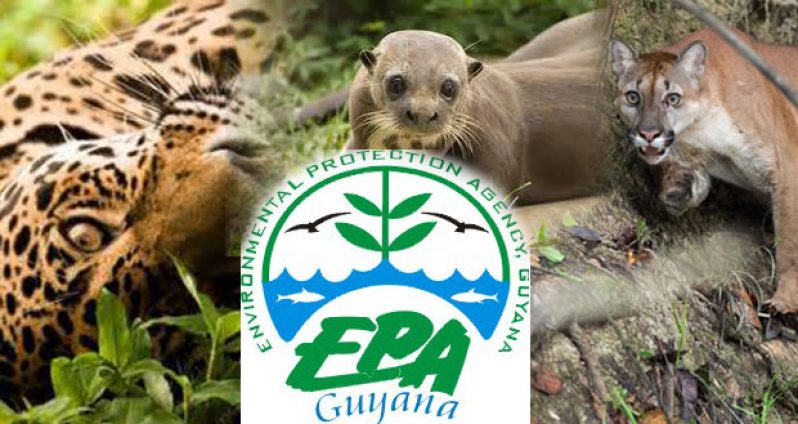This week we will focus on a very important plant species well known across the coastal plains of Guyana.
Mangroves cover about 290 km of Guyana’s 430 km coast, and line many of our rivers. They are unique plant species as they can survive under harsh conditions, such as water poor in oxygen, salt water, and brackish water (a mixture of salt and fresh water).
They are fast growers and reach up to 25m. Worldwide, mangroves cover approximately 172,000 km2 of the earth’s surface. However, about 35% of this was lost during the last several decades. The quantity of mangrove forests in Guyana has also been declining.
TYPES
In all, there are seven species of mangroves. Three of these (the red, black and white mangroves) are found in Guyana.
Red Mangrove (Rhizophora mangle)
The red mangrove is easily recognised by its exposed prop and aerial root system which stabilises the tree, and also by the long seedlings (propagules) that hang from the branches.
Red mangroves are commonly found along inland rivers.
Black Mangrove (Avicennia germinans)
Also known as Courida, this type inhabits Guyana’s coastline, which is washed by the Atlantic Ocean. It is not usually found along river banks. Black mangroves, like red mangroves, are easily identified by their roots. However, it is not the exposed prop roots that make the black mangroves stand out. Instead it is the numerous breathing tubes, called pneumatophores, which stick vertically out of the ground. These pneumatophores trap oxygen for the plant.
White Mangrove (Laguncularia racemosa)
This type grows shorter than the red or black mangroves and is found in the back portion of the mangrove forest. The white mangrove’s leaves have special openings/glands which allow salt to pass from inside the plant to the outside. This causes a coating of white salt crystals to remain on the leaves, hence the name white mangrove.
IMPORTANCE
Mangrove forests provide a range of services which benefit both the environment and us. They:
• Trap and cycle various organic materials, chemical elements, and important nutrients in the coastal ecosystem.
• Provide food for marine organisms.
• Provide physical habitat and nursery grounds for a wide variety of marine organisms, such as fish, shrimp and crabs.
• Serve as roosting and nesting sites for many of our birds.
• Serve as storm buffers by reducing wind and wave action in shallow shoreline areas.
• Assist in protecting water quality and clarity by filtering runoff and trapping sediments and debris from adjacent uplands.
Mangroves are important sea defence structures. They break the force of waves and reduce erosion. Without these mangroves most of Guyana’s coastline would have been severely eroded leading to bank collapse and increased flooding. Fishes, shrimp, crabs and other organisms would lose their habitat and their numbers would decrease. Since it is these same organisms which we harvest for food, fewer organisms would mean less food for us.
RESTORATION
Given the threat of climate change and sea level rise along with the fact that Guyana’s coast is below sea level, it is especially important for us to maintain our mangrove forests. To achieve this, the Guyana Mangrove Restoration Project (GMRP) was launched in February 2010 with funding by the European Union (EU).
Stretches of mangrove forests were restored along the coast and persons were educated on the importance of these forests. Subsequently, the GMRP was undertaken by the National Agriculture Research Extension Institute in 2013.
Additionally, mangroves have been declared a protected species in Guyana and there is a fine for illegal cutting of mangroves. You MUST receive a permit from the Guyana Forestry Commission before destroying any mangrove tree. Although there is no specific legislation in Guyana concerning mangroves, there are clauses in four legal documents, namely the Environmental Protection Act, the Sea Defence Act, the Fisheries Act and Forest Acts that can be interpreted to include regulation over the management of mangroves.
WHAT CAN YOU DO?
You can:
• Avoid grazing animals in mangrove areas
• Avoid careless cutting of trees for fuel wood and poles for fishing nets.
• Harvest tannins in the amount needed and with responsible harvesting techniques
• Avoid dumping garbage at mangrove sites
• Avoid pulling fishing boats through the mangrove forest
• Talk to other persons about avoiding the above bad practices
Sources:
http://www.mangrovesgy.org
https://envirodiva.wordpress.com/tag/white-mangrove/
You can share your ideas and questions by sending letters to: “Our Earth, Our Environment”, C/O EIT Division, Environmental Protection Agency, Ganges Street, Sophia, GEORGETOWN, or email us at: eit.epaguyana@gmail.com




.png)









